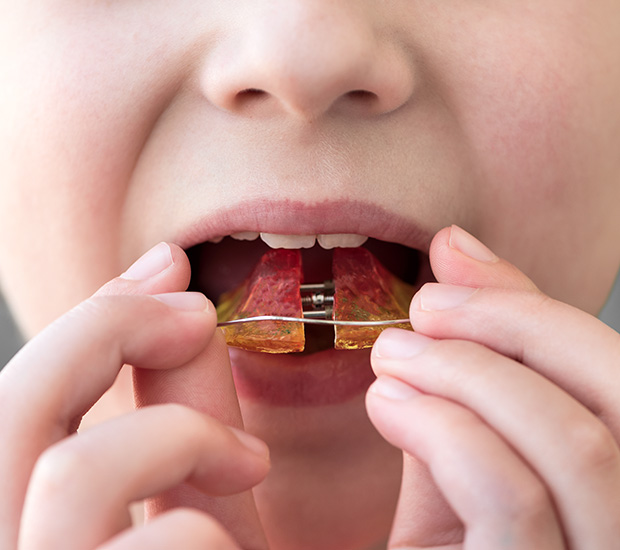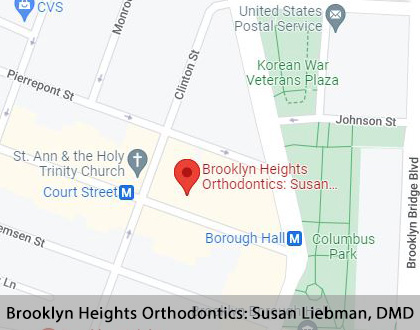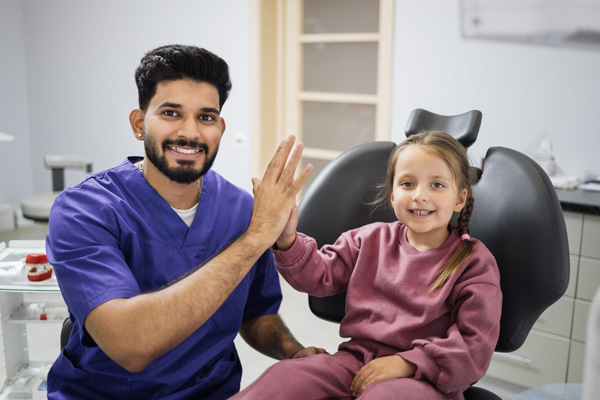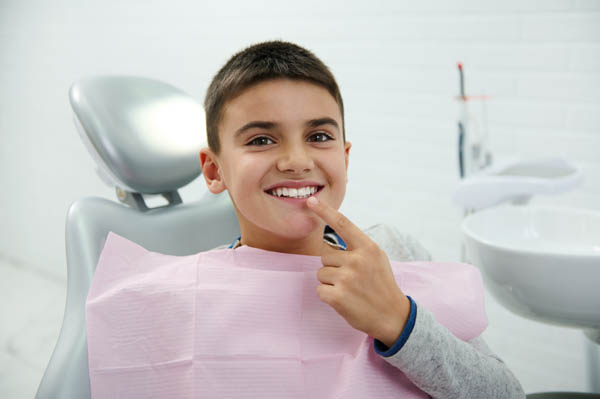Phase One Orthodontics Brooklyn, NY
Phase One orthodontics is an interceptive orthodontic treatment that addresses major dental problems in a young child’s mouth. This early orthodontic treatment can prevent more severe issues from occurring in the future, which may require complex orthodontic treatment such as permanent tooth extraction or orthognathic surgery. Phase One orthodontics allows orthodontists to create space for the permanent teeth and address the patient’s jaw structure to correct bite problems.
Brooklyn Heights Orthodontics: Susan Liebman, DMD provides phase I orthodontics in Brooklyn and the surrounding area. Our team can determine whether your child can benefit from corrective dental treatment. Call us today at (718) 416-6368 to learn more about our services or schedule an appointment.
Understanding Phase One Orthodontics
Phase One orthodontics is recommended when there is an immediate orthodontic problem in a young child that requires treatment. Children with severe jaw or tooth issues are good candidates for this treatment. Such orthodontic issues may include crossbites, underbites, severe overbites, jaw growth discrepancies, crowding, flared upper teeth, and spacing issues.
While some orthodontic issues may result from genetics, others may be due to injuries, early or late baby tooth loss, or habits, such as thumb sucking. Children who receive phase I orthodontics can benefit from proper teeth and jaw growth and a strong foundation for permanent teeth eruption. Early orthodontic treatment can also lower the risk of speech problems, periodontal diseases, cavities, and oral injuries.
“While some orthodontic issues may result from genetics, others may be due to injuries, early or late baby tooth loss, or habits, such as thumb sucking.”
Phase One Orthodontic Treatments
Patients may receive a combination of brackets and wires, palatal expanders, and space maintainers during phase I orthodontic treatment. The appliance used will depend on each patient and their needs. Palatal expanders are the most common early orthodontic treatment. They can correct crowding problems, make room for erupting adult teeth, correct skeletal issues like crossbites, and increase the nasal capacity for better breathing.
Space maintainers help manage premature baby tooth loss and prevent teeth misalignment, overcrowding, and other orthodontic conditions. Some children may also benefit from partial braces on their upper or lower front teeth to provide early minor correction for crossbites, crowded teeth, and spacing issues.
“Patients may receive a combination of brackets and wires, palatal expanders, and space maintainers during phase I orthodontic treatment.”
Phase One Treatment Length
The American Association of Orthodontics (AAO) recommends all children have their first orthodontic appointment by age seven. This appointment is not necessary to begin phase I treatment but to evaluate whether a child needs interceptive treatment for proper teeth growth and development. Children who need phase I orthodontics will usually start treatment between the ages of six and 10, during the mixed dentition phase.
Throughout this age range, the children’s jawbones are unfused, allowing for easier correction of crowding, skeletal, and breathing issues. Phase One treatment can take six to 18 months for most patients. After the correction is complete, the patient will wear a retainer to maintain the adjustments as they wait for their permanent teeth to erupt.
“Children who need phase I orthodontics will usually start treatment between the ages of six and 10.”
Check out what others are saying about our orthodontic services on Yelp: Phase One Orthodontics in Brooklyn, NY
Moving On To Phase Two Treatment
After phase I orthodontics, children will continue to lose their remaining baby teeth while their permanent teeth erupt. Patients can move on to phase II treatment once all their adult teeth are in, usually around age 11 or older. Children who receive phase I orthodontic treatment often benefit from a shorter phase II treatment without the need for tooth extractions or surgery.
Not every child will need phase I orthodontic treatment. Some patients have shifted teeth that do not require immediate intervention and can wait to receive phase II treatment instead. However, it is still important for children to have orthodontic evaluations to determine the most advantageous time to begin treatment.
“Patients can move on to phase II treatment once all their adult teeth are in, usually around 11 to 12 years old.”
Questions Answered on This Page
Q. When is phase I orthodontics necessary?
Q. What are phase I orthodontic treatments?
Q. How long does phase I orthodontic treatment take?
Q. When can patients move onto phase II orthodontics?
Q. What qualifications do orthodontists have?
People Also Ask
Q. What is Phase Two orthodontic treatment?
Orthodontist Qualifications
Orthodontists attend dental school like general and pediatric dentists but must also receive additional training and education. After dental school, people must complete a two to three-year orthodontic residency program to become specialists in orthodontics. They specialize in correcting misaligned bites, fixing jaw problems, and straightening teeth.
An orthodontist has the qualifications to treat patients of all ages, including young children. Orthodontists focus specifically on orthodontics and have the skills and experience to help children achieve healthy and attractive smiles. As specialists in jaw and tooth alignment, orthodontists can create personalized plans for patients and recommend them the right type of appliances for their needs.
“After dental school, people must complete a two to three-year orthodontic residency program to become specialists in orthodontics.”
Frequently Asked Questions
Q. Will my child still need braces after phase I orthodontics?
A. Most children will still need braces after phase I orthodontics. However, the time children will need to spend in braces is often shorter. This quicker treatment time is due to the correction of the underlying issues during the early orthodontic intervention.
Q. How does a space maintainer work?
A. Space maintainers work by keeping the space left by a lost baby tooth. This appliance allows permanent teeth to erupt normally. Without a space maintainer, the teeth can shift into the open space and result in more severe issues.
Q. How does a palatal expander work?
A. Palatal expanders work by widening the two halves of the patient’s upper jaw. Our team customizes expanders for each patient’s unique needs. The palatal expander can be fixed or removable.
Q. What happens if my child does not see an orthodontist until all of their permanent teeth erupt?
A. We do not recommend waiting to seek treatment. Waiting for permanent teeth to erupt or completing facial growth can make some orthodontic problems more difficult to correct. Some orthodontic problems may not be fixable once the face and jaw growth is complete.
Q. Do aesthetics matter during phase I orthodontics?
A. Intervention during phase I orthodontics is not done for the sake of a child’s appearance. While a child’s baby teeth can move during phase I orthodontics, the movement ensures there is enough space for permanent teeth. This intervention may result in improved aesthetics, but it is not the goal of this treatment.
Quality Orthodontic Services Can Transform Smiles
By visiting us as soon as possible, our team can help get you the professional treatment you need.
Definition of Orthodontic Terminology
Call Us Today
Depending on the orthodontic problem, some young children can benefit from phase I orthodontics. Our team at Brooklyn Heights Orthodontics: Susan Liebman, DMD can determine whether this interceptive treatment is right for your child’s orthodontic needs. Call us today at 718-416-6368 to learn more about our services or schedule an appointment.
Helpful Related Links
- American Dental Association (ADA). Glossary of Dental Terms. 2021
About our business and website security
- Brooklyn Heights Orthodontics: Susan Liebman, DMD was established in 1963.
- We accept the following payment methods: American Express, Cash, Check, Discover, MasterCard, and Visa
- We serve patients from the following counties: Kings County
- We serve patients from the following cities: Brooklyn, Cobble Hill, Clinton Hill, Williamsburg, Boerum Hill, Brooklyn Heights, Park Slope, DUMBO, and Prospect Heights
- Norton Safe Web. View Details
- Trend Micro Site Safety Center. View Details
Back to top of Phase One Orthodontics







